|
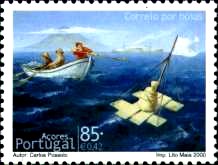
| Maritime Topics On Stamps :
Floating Mail Containers!
| |
Picking up a postbuoy!
|

| |
From 1909 the Orient Steam Navigation Company was contracted to pick
up and deliver mail for the Cocos (Keeling) Islands as part of the UK-Australia
mail service. After the P&O took a controlling interest
in the Orient Line in 1917 their ships also took part in this service.
|
Due
to the lack of a suitable anchorage and the small population being
served, the mail was dropped off and picked up without the ships
actually stopping! Sealed barrels of mail would be taken out by island
boats and floated alongside the ship as it slowed down to pick them
up. Similarly the ship would throw barrels containing the incoming
mail into the water for the boats to bring back to shore.
The service was discontinued in 1955 when an air service to the
islands began. This mail delivery system was always for genuine postal
needs, as opposed to the 'Tin Can Mail' of Niuafo'u which degenerated
into a tourist gimmick and thus gained much more publicity.
| 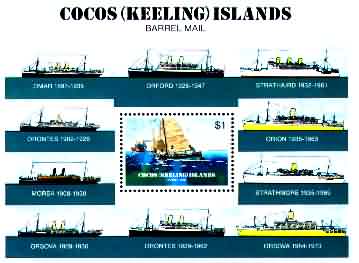
| |
The 70c stamp shows the P&O ship 'Morea'. The $1 stamp in the souvenir
sheet shows the retreating stern of what is most likely an Orient Line
ship of the 1930's or 1950's , judging by the hull colour and single
funnel. All other ships in the margin of the S.S. are Orient or P & O
liners.
|
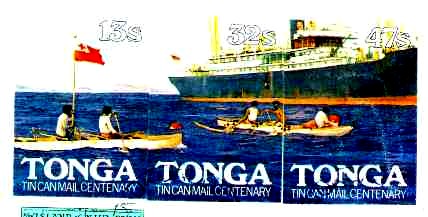
|
On the Tonga Islands many traders bought copra and shells from the
islanders. Their mail was delivered by trading ships in addition to
the normal cargo. But very often the trading ships simply passed by
the islands, as their captains shyed the danger of navigating through
the reefs for a handful of letters only. So the traders often had to
wait for many months.
In 1882 the so-called 'Tin Can Mail' was developed. The mail was enclosed
in large metal containers for buoyancy and thrown over board from the
steamers to be collected by islanders in outrigger canoes. This mail
service continued for more than 50 years. In 1930 even ocean liners crossing
the Pacific would pause at Niuafo'ou in order to allow their passengers
tohe use of this postal service.
Celebrating the 100th anniversary in 1982, the Tonga Postal Office
issued these stamps.
|
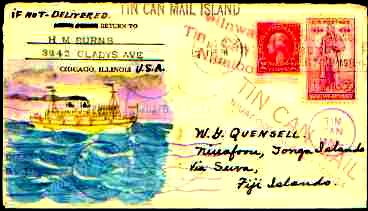
|
|
The postbuoy is a floating mailbox. 'You can start writing a letter
today, tomorrow we will pass a postbuoy.' With this nice joke veteran
sailors had amazed the ship boys on many ships. But from the past up
to today there were and there are postbuoys. On the first stamp at the
top of this page we can see fishermen picking up a postbuoy off the
coast of the Acores. These buoys were dropped off by passing ships.
They had the same function as the 'Tin Can Mail' (mentioned above) or
'Barrel Mail' and contained the mail for the islands people.
| |
On the stamp mark we can see an anchored buoy at the 'Steinhuder Meer'
near Hannover, Germany. It has been in place for over 25 years and is
a real, working mailbox. Originally te buoy was placed into the sea
after a bet, but today it is officially acknowledged by the Postal
Authority. Round about 1,200 letters per year pass the buoy as the
local sailing club empties it two times per week. The bouy is marked
in the authorized charts of the Water- and Shipping Authority.
|
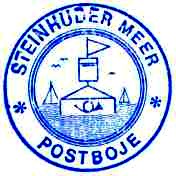
|
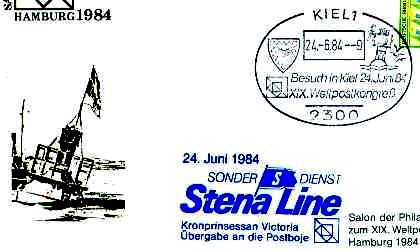 |
On this cover we can see a picture and a post mark of a postbuoy which
was placed in the Kiel Bight in June 1984. The reason was the visit of
the 19th World Postal Congress, who was working in Hamburg at that
time. At the end of the Kiel Week it was a nice public relation idea
to call peoples attention to the congress and to the philately.
|
|
There are three reasons for bottle post being: Firstly it was used in
need and danger. Shipwrecked sailors and marooned pirates on island
used her. The messages in the closed bottles were thrown into the sea.
For example in 1954 a bottle post of the vessel 'Melanie Schulte' was
found. The ship was missing for two years and was declared lost. The
message told the sad tale of her disappearance: The 'Melanie Schulte'
ran on a mine (source: German philately dictionary).
|
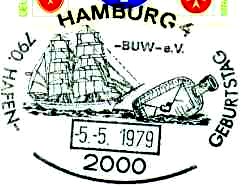
|
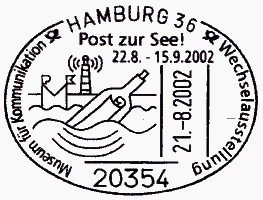
|
Secondly the bottle post was used to discover and research great ocean
currents. And thirdly by just for fun.
The fastest bottle post crossing the Atlantic Ocean from New Foundland
to Ireland took 33 days. The longest drift recorded took 359 years for
the distance Caribean Sea to Gibraltar. According to philatelistic
research this bottle post was sent by Christopher Columbus himself
(source: German philately dictionary).
| |
On his homebound voyage from the Caribic Sea to Spain Columbus
encountered a hurricane. As he was in fear that his ships would
sink and nobody would know anything about his great discoveries,
he wrote a long letter. This letter was put into a barrel
and thrown overboard.
Columbus recorded the event in his personal diary. The barrel itself
was never found.
Since 1887 the German Hydrographic office 'Deutsche Seewarte'
issued a form for bottle mail to all German shipmasters. These
forms were put in bottles and had to be thrown overboard at
predefined positions to aid sea stream reseach. The finders were
asked to send the mail back with a notice about date and location
the bottle mail was found. Roundabout 600 bottles came back.
|
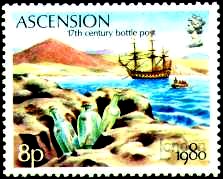
|
The 'Ascension Bottle Post' became an established practice in the 17th
century. The procedure was firstly recorded in 1673 by the travelling
missionary friar Domingo Navarrete and was still in use when Louis de
Bougainville, captain of the 'La Boudeuse' arrived in 1769. On the
stamp we can see that the bottles were actually not thrown into the
water, but placed on rocks at the shore.
|
|
'Ball Post' was a mail-transfer in waterproofed zinc balls, which were
able to drift under the surface of the water, moved only by the
currents - the very first 'sub- water-post'. This method was
introduced in 1871 when French troops tried to reach the defenders of
the besieged Paris. The inlet of a zinc ball was exactly calculated,
so it could float downtream beneath the surface of the river Seine.
There were 500 to 600 letters to one ball, everyone weighing less than
four grammes. 55 balls were cast into the river upstream of Paris, but
no ball reached its destination during the war. Eleven balls were
recovered from May 1871 to 1876. And another four ones in 1884, 1910,
1942 and even 1970!
|
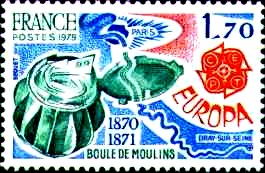
|
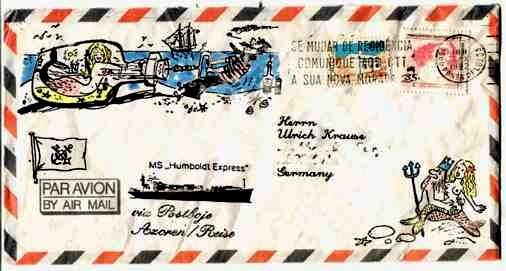 | |
As we can see on this letter, even today postbuoys are
constructed and deployed off the coast. The people of the Acores
island Punta Del Gada pick up every floating barrel, because they
know, that besides the mail there are always Dollars, cigarettes
and whiskey inside. The Portugese post authority issued a stamp
of this scene (see the beginning of this page). You can find a
detailed report about the Acores mail (in German) on the
following page:
http://biedekarken-chr.bei.t-online.de/azoren.htm
|
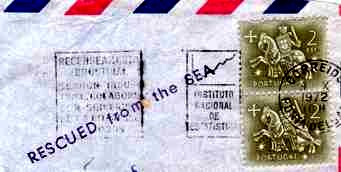
|
The cancellation 'Rescued from the sea' tells the same story - a
mail from the Acores as well.
|
|
Another example from a German ship, mail via a postbuoy.
|
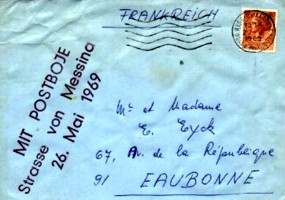 |
|